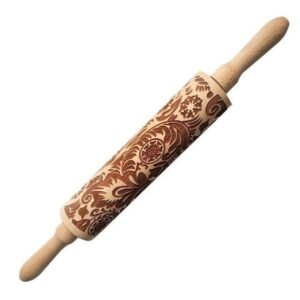Introduction
Embark on a flavorful adventure as we delve into the world of Chinese cuisine. With its rich culinary history dating back thousands of years, Chinese food has captivated palates around the globe. Known for its unique flavors, wide variety of ingredients, and meticulous preparation techniques, it offers an unparalleled gastronomic experience.
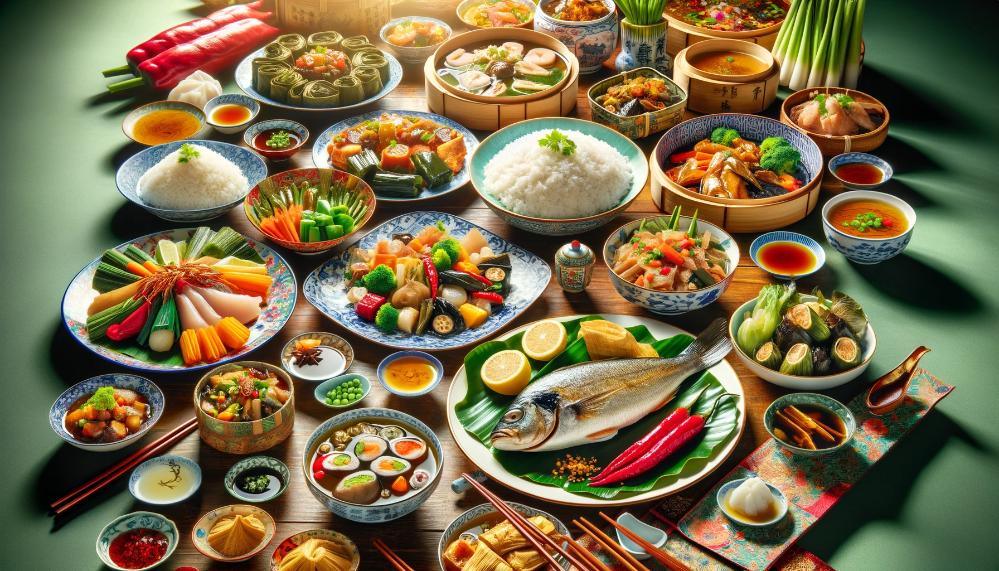
From the fiery Sichuan peppercorns to the delicate artistry of dim sum, Chinese cuisine tantalizes taste buds with its diverse range of dishes. Whether you’re craving the numbing sensation of prickly ash or savoring the umami-rich flavors of soy sauce, each bite tells a story steeped in tradition and cultural heritage.
Join us as we explore the vibrant tapestry of Chinese cuisine – from regional specialties to time-honored cooking methods. Get ready to indulge in mouthwatering delicacies that showcase the harmonious blend of flavors and textures that define this extraordinary culinary tradition.
History
The history of Chinese cuisine is a fascinating journey that dates back to ancient times. Over the centuries, it has evolved and been influenced by various dynasties and regions, resulting in the diverse culinary landscape we know today.
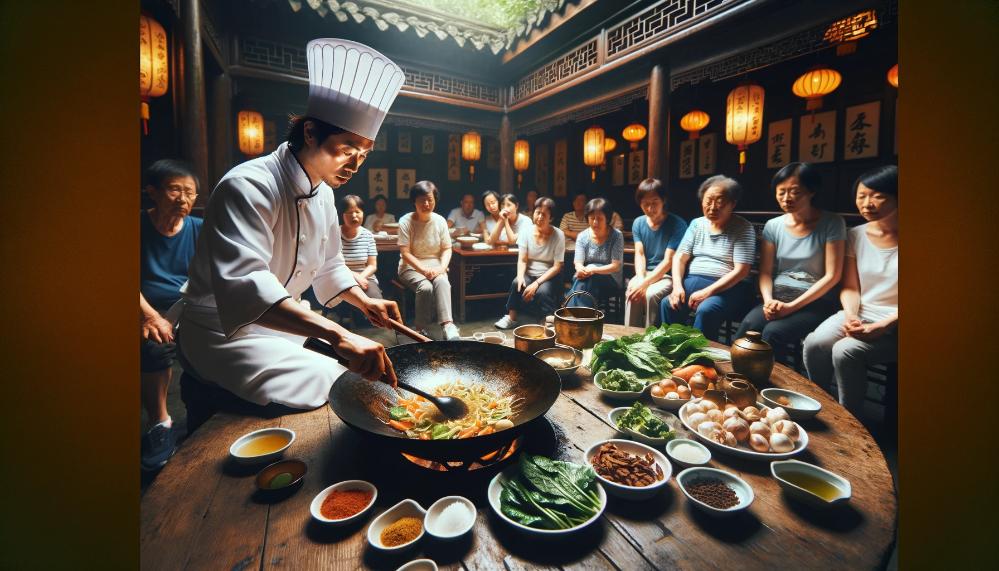
Trade routes played a significant role in spreading Chinese culinary traditions. As merchants traveled across different parts of China, they brought with them new ingredients, cooking techniques, and flavors. This exchange of ideas and ingredients contributed to the development and enrichment of Chinese cuisine.
Chinese culture places great importance on food as an integral part of daily life. From family gatherings to festive celebrations, food plays a central role in bringing people together. It is not just about satisfying hunger but also about nourishing the body and soul.
One popular aspect of Chinese cuisine is its emphasis on soups. Soups are considered a fundamental part of every meal, as they provide nourishment and balance to the overall dining experience. Whether it’s a clear broth or a hearty stew, soups are often packed with nutritious ingredients like vegetables, meats, and herbs.
Another interesting aspect is the philosophy behind Chinese cooking techniques. Many traditional methods involve using one’s hands instead of relying solely on utensils. For example, making dumplings requires skillful hand movements to shape the delicate dough into perfect little parcels filled with savory fillings.
Chinese cuisine also has regional variations that reflect the unique characteristics of different parts of China. From the fiery flavors of Sichuan cuisine to the delicate tastes of Cantonese dishes, each region has its own distinct culinary identity.
One popular dish that showcases this regional diversity is “jianbing,” a type of street food commonly found in northern China. Jianbing is essentially a savory pancake made from batter mixed with various fillings such as eggs, scallions, cilantro, and crispy fried dough sticks called “youtiao.” It’s a quick and delicious breakfast option that locals enjoy on-the-go.
The name “Chinese cuisine” itself is a broad term that encompasses a wide range of dishes and cooking styles. It’s important to remember that within China, there are countless regional cuisines with their own unique flavors and traditions.
Regional Cuisines
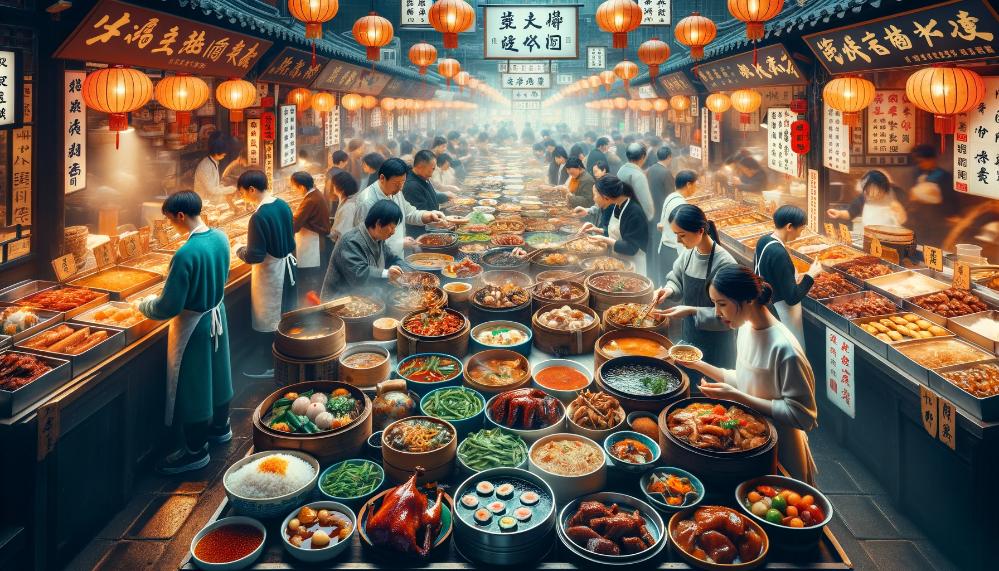
China, a country known for its rich culinary traditions, is home to eight major regional cuisines, each offering its own distinct flavors and styles. These regional cuisines have developed over centuries and reflect the diverse cultural influences, local ingredients, and unique cooking techniques of different regions in China. Let’s explore some of the famous regional cuisines that make Chinese cuisine so fascinating.
Sichuan: Fiery and Flavorful
Sichuan cuisine is renowned for its bold and spicy flavors. The use of Sichuan peppercorns gives dishes a numbing sensation that pairs perfectly with the heat from chili peppers. Popular Sichuan dishes include Mapo Tofu, Kung Pao Chicken, and Hot Pot. The combination of spices and ingredients creates a symphony of flavors that will leave your taste buds tingling.
Cantonese: Delicate and Diverse
Cantonese cuisine hails from Guangdong province in southern China. Known for its delicate flavors and emphasis on fresh ingredients, Cantonese cuisine offers a wide range of dishes to satisfy every palate. Dim Sum is a beloved culinary tradition in Cantonese culture, featuring an array of bite-sized delicacies like dumplings, steamed buns, and rice rolls. From succulent roasted meats to flavorful seafood dishes, Cantonese cuisine showcases the diversity of Chinese cooking.
Shandong: Hearty and Robust
Originating from the eastern coastal province of Shandong, this cuisine focuses on simple yet hearty flavors. Shandong cuisine places great importance on using high-quality ingredients such as seafood and grains. One famous dish is Sweet and Sour Carp—a crispy fish served with a tangy sauce that perfectly balances sweet and sour flavors. With its emphasis on freshness and simplicity, Shandong cuisine captures the essence of traditional Chinese cooking.
Hunan: Spicy with Intense Flavors
Hunan cuisine, also known as Xiang cuisine, is characterized by its bold and spicy flavors. The use of chili peppers and garlic gives dishes a fiery kick that sets it apart from other regional cuisines. Popular Hunan dishes include Spicy Chicken, Chairman Mao’s Red-Braised Pork, and Steamed Fish Head with Chopped Chili. If you have a love for spicy food, Hunan cuisine will not disappoint.
Each of these regional cuisines represents the culinary diversity found across China’s different regions. From the fiery flavors of Sichuan to the delicate dim sum of Cantonese cuisine, there is something to tantalize every taste bud. Exploring these regional cuisines allows us to appreciate the rich cultural heritage and gastronomic delights that Chinese cuisine has to offer.
Staple Foods
Rice and noodles are the stars of Chinese cuisine. They form the foundation of many meals and are widely consumed across different regions in various forms.
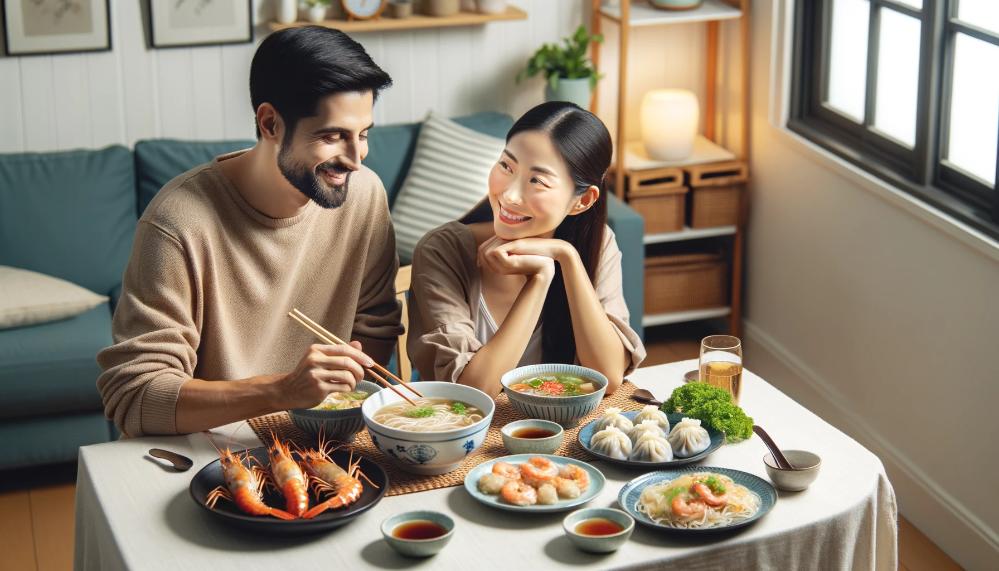
Rice: The Ultimate Staple Food
In most parts of China, rice takes center stage on the dinner table. It is a versatile grain that can be cooked in numerous ways, such as steamed, fried, or boiled. Rice provides a satisfying base for dishes like stir-fries, curries, and soups. Whether you’re enjoying a plate of Yangzhou fried rice or a comforting bowl of congee, rice is an essential part of Chinese cuisine.
Noodles: A Delicious Alternative
Noodles are another beloved staple food in China. With countless varieties available, from thin to thick, wheat-based to rice-based, there’s a noodle dish to suit every palate. You’ll find stir-fried noodles tossed with colorful vegetables and meats or slurp-worthy bowls of soup noodles garnished with fragrant herbs and spices. Whether it’s chow mein or lo mein, dan dan noodles or biang biang noodles, these delicious strands bring joy to every meal.
Wheat Products: Dumplings and Steamed Buns
Apart from rice and noodles, wheat products also play a significant role in Chinese cuisine. Dumplings (jiaozi) are small pockets of dough filled with savory mixtures of meat or vegetables. They are traditionally eaten during festivals like Chinese New Year but have become popular year-round due to their delicious taste.
Steamed buns (baozi) are another favorite made from wheat flour dough that is filled with various ingredients like pork or vegetables before being steamed until fluffy and soft. These buns make for a tasty breakfast or snack option.
Chinese cuisine encompasses an array of staple foods beyond just rice and noodles. Vegetables such as bok choy, broccoli, and Chinese cabbage are commonly used in stir-fries and soups. Meats like pork, beef, and chicken feature prominently in many dishes, while seafood lovers can savor delicacies like crispy fried fish or steamed whole fish.
To add flavor to their dishes, the Chinese use a variety of seasonings and condiments. Garlic, ginger, soy sauce, and vinegar are staples in most kitchens. Spices like Sichuan peppercorns and chili peppers bring heat and complexity to dishes like mapo tofu or Kung Pao chicken.
While dairy products are not as prevalent in traditional Chinese cuisine, soybean-based products take their place. Soy milk is a popular alternative to cow’s milk, often enjoyed with breakfast or used as an ingredient in desserts. Tofu (bean curd) is another versatile ingredient that can be stir-fried, braised, or added to soups.
Popular Chinese Dishes
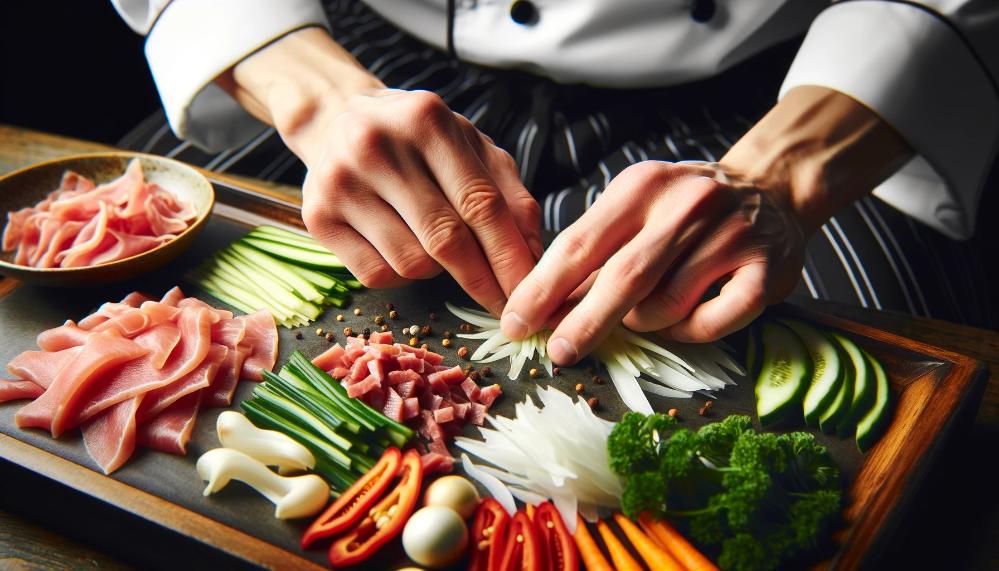
Chinese cuisine is famous for its diverse flavors and unique dishes. Let’s explore some of the popular Chinese dishes enjoyed worldwide.
Kung Pao Chicken
One of the most well-known Chinese dishes is Kung Pao Chicken. It is a flavorful stir-fry dish that combines tender chicken, crunchy peanuts, and spicy chili peppers. The sauce is a perfect balance of sweet, savory, and tangy flavors. Kung Pao Chicken is loved for its bold taste and satisfying texture.
Sweet and Sour Pork
Another favorite among Chinese cuisine enthusiasts is Sweet and Sour Pork. This dish features succulent pieces of pork coated in a sticky, tangy sauce made with vinegar, sugar, ketchup, and soy sauce. The combination of crispy meat and vibrant flavors creates a delightful culinary experience.
General Tso’s Chicken
General Tso’s Chicken has gained immense popularity in Western countries. This dish consists of deep-fried chicken pieces tossed in a rich, sweet, and slightly spicy sauce. The crispy exterior combined with the tender chicken makes it an irresistible choice for many.
Dim Sum
Dim Sum is not just a single dish but rather a style of eating that involves small bite-sized portions served in steamer baskets or on small plates. It is often enjoyed during brunch or lunchtime gatherings with friends or family. Dim Sum offers a wide variety of options such as dumplings filled with meat or vegetables, steamed buns, rice rolls, and more.
Peking Duck
Peking Duck is a renowned dish originating from Beijing (formerly known as Peking). It features succulent duck meat with crispy skin served alongside thin pancakes, scallions, cucumber slices, and hoisin sauce. The combination of textures and flavors creates an unforgettable dining experience.
Chinese cuisine encompasses much more than just these popular dishes mentioned above; however, they provide an excellent introduction to the diverse flavors and culinary traditions of China. Whether you are a fan of spicy, sweet, or savory flavors, Chinese cuisine has something to offer for everyone.
So the next time you’re in the mood for some mouthwatering Chinese food, consider trying Kung Pao Chicken, Sweet and Sour Pork, General Tso’s Chicken, Dim Sum, or Peking Duck. These dishes will surely satisfy your taste buds and leave you craving for more!
Traditional Chinese Food Dishes

Traditional Chinese cuisine is renowned for its diverse flavors and unique culinary techniques.One of the key aspects is the art of balancing flavors. Sweet, sour, salty, bitter, and spicy flavors are carefully combined to create a harmonious taste experience.
Balancing Flavors
Chinese cuisine places great emphasis on achieving a balance of flavors in every dish. Each flavor has its significance and contributes to the overall taste profile. For example, Mapo Tofu from Sichuan province is known for its numbing spiciness balanced with the richness of tofu and aromatic spices. Similarly, Beggar’s Chicken from Jiangsu province combines savory chicken with fragrant herbs and spices.
Symbolic Meanings
Many traditional Chinese dishes have symbolic meanings associated with festivals or special occasions. For instance, during Lunar New Year celebrations, families often prepare Jiaozi dumplings together. These dumplings symbolize wealth and prosperity because their shape resembles ancient Chinese gold ingots.
Regional Specialties
China’s vast landmass gives rise to a rich diversity of regional cuisines. Each region has its own signature dishes that showcase local ingredients and cooking styles. Anhui cuisine, for example, is known for its emphasis on wild herbs and braising techniques. One popular Anhui dish is “Sticky Rice Noodles,” which features tender slices of pork belly served over sticky rice noodles soaked in a flavorful broth.
Popular Dishes
There are several classics that come to mind. Fried rice is a staple that can be found in almost every Chinese restaurant around the globe. It combines fluffy rice with various ingredients like vegetables, meat, or seafood cooked in a wok at high heat for that irresistible smoky flavor.
Another beloved dish is Xiaolongbao – delicate steamed soup dumplings filled with juicy meat or vegetables. These little pockets of goodness burst with savory broth when you take a bite, making them a favorite among dumpling enthusiasts.
Sauces and Condiments
Chinese cuisine is also famous for its wide array of sauces and condiments that enhance the flavors of dishes. Hoisin sauce, made from soybeans, garlic, vinegar, and spices, adds a sweet and tangy taste to stir-fries and marinades. Bean curd or tofu is another versatile ingredient used in many Chinese dishes. It can be fried, steamed, or added to soups for added texture and flavor.
Different Types of Chinese Drinks
Chinese cuisine is not just about the food; it also offers a wide variety of beverages that complement and enhance the dining experience. Let’s explore some of the different types of Chinese drinks that are popular in Chinese culture.
Tea: A Staple in Chinese Culture
Tea holds a special place in Chinese culture and is deeply ingrained in daily life. It is not just a beverage but an integral part of social gatherings, ceremonies, and even traditional medicine. There are various types of tea enjoyed in China, each with its own unique flavor and characteristics.
• Green Tea: Known for its refreshing taste and health benefits, green tea is one of the most popular choices among tea lovers. It undergoes minimal oxidation during processing, resulting in a delicate flavor profile.
• Black Tea: With a stronger flavor compared to green tea, black tea is often enjoyed with meals or as an energizing morning beverage. It goes through full oxidation during processing, giving it a rich and robust taste.
• Oolong Tea: Falling between green and black teas, oolong tea combines the best qualities of both. It has a diverse range of flavors, from floral to fruity notes, making it a versatile choice for different palates.
Baijiu: The Strong Spirit
For those seeking something stronger than tea, baijiu is a traditional Chinese liquor that packs quite a punch. Made from grains such as sorghum or rice, baijiu has been enjoyed for centuries across China. It has a high alcohol content and distinct flavors that vary depending on the production method and ingredients used.
Herbal Soups and Medicinal Drinks
In addition to teas and spirits, herbal soups and medicinal drinks are also prominent in traditional Chinese medicine practices. These beverages are believed to have various health benefits due to their herbal ingredients and preparation methods.
Herbal soups often contain ingredients like ginseng, goji berries, and Chinese dates. They are simmered for hours to extract the flavors and medicinal properties of the herbs, resulting in a nourishing and flavorful drink.
Medicinal drinks, on the other hand, are specifically formulated to address specific health concerns. They may include ingredients like dried herbs, roots, or even animal parts. These drinks are often consumed as part of a holistic approach to wellness in Chinese medicine.
Conclusion
A flavorful journey through the diverse and vibrant world of Chinese cuisine. From the rich history to the regional specialties, we’ve explored the various aspects that make Chinese food so beloved worldwide. Whether it’s the comforting flavors of dim sum or the fiery spice of Sichuan cuisine, Chinese dishes never fail to tantalize our taste buds.
Step into your kitchen and embark on your own culinary adventure. Try your hand at making some classic Chinese dishes or experiment with fusion recipes that combine the best of both worlds. And don’t forget to share your creations with friends and family, because food is best enjoyed when shared.
FAQs
What is Chinese cuisine known for?
Chinese cuisine is known for its diverse flavors, vibrant colors, and the use of fresh ingredients. From spicy Sichuan dishes to delicate Cantonese dim sum, Chinese cuisine offers a wide range of flavors and cooking techniques that cater to different tastes.
What are some popular dishes in Chinese cuisine?
Some popular dishes in Chinese cuisine include Peking duck, Kung Pao chicken, sweet and sour pork, dumplings, fried rice, and hot pot. These dishes represent the rich culinary heritage of China and showcase the variety of flavors and ingredients used in Chinese cooking.
Are all Chinese dishes spicy?
No, not all Chinese dishes are spicy. While some regional cuisines like Sichuan are famous for their fiery flavors, other regions such as Cantonese or Shanghainese offer milder options. Whether you prefer mild or spicy food, there’s always something delicious to try in Chinese cuisine.
What are the staple ingredients in Chinese cooking?
Staple ingredients in Chinese cooking include rice, noodles, soy sauce, ginger, garlic, sesame oil, and various vegetables like bok choy and mushrooms. These ingredients form the foundation of many traditional Chinese recipes and contribute to the distinctive flavors found in this cuisine.
Is Chinese food healthy?
Yes! When prepared using fresh ingredients and balanced cooking methods like stir-frying or steaming, Chinese food can be a healthy choice. With its emphasis on vegetables and lean proteins like fish or tofu, it offers a nutritious option for those looking to enjoy flavorful meals while maintaining a balanced diet.
Frequently Linked Pages
1. Nearest Chinese Restaurant – Find The Nearest Chinese Restaurants: Uncover The Best!
2. Best Chinese Restaurants Near Me – Best Chinese Restaurants Near Me in Richmond, VA
3. Chinese Restaurant 888 – Chinese Restaurant 888 – Order Authentic Cuisine Online




